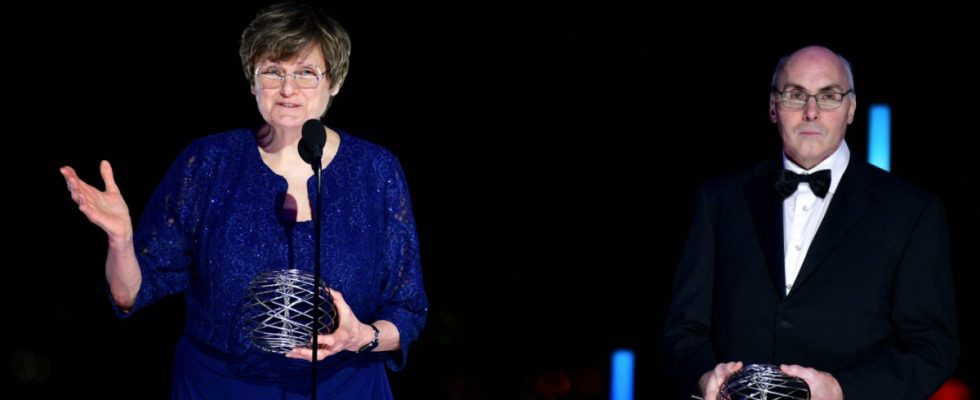The Nobel Prize in Medicine goes to Katalin Karikó and Drew Weissman. The two scientists have created the basis for mRNA vaccines that have been used in the fight against Corona.
The researchers have already been informed by the Nobel Assembly and they were very pleased, said Thomas Perlmann from the Swedish Karolinska Institute. “They are overwhelmed,” said Perlmann when announcing the award.
Katalin Karikó was born in the Hungarian city of Szolnok in 1955 and studied biology at the University of Szeged, where she received her doctorate in 1982. In 1989 she went to the University of Pennsylvania as an assistant professor and stayed until 2013. In the same year she met Uğur Şahin, who founded the company Biontech with his wife Özlem Türeci. Karikó once said that he offered her a job that same day New York Times; She accepted him and from then on led a research team in the company. After years of working together, she left the company and is now its consultant. In 2021 she returned to her old place of work and became a professor at the University of Szeged and an associate professor at the Perelman School of Medicine at the University of Pennsylvania.
Drew Weissman was born in Lexington, Massachusetts in 1959 and studied biochemistry at Brandeis University. He completed his clinical training at Beth Israel Deaconess Medical Center at Harvard Medical School and did postdoctoral research at the National Institutes of Health. In 1997, Weissman founded his research group at the Perelman School of Medicine at the University of Pennsylvania.
With mRNA vaccines, parts of the pathogen itself are not injected
Both researchers are considered pioneers of mRNA technology, which gained worldwide fame with the corona vaccines. Karikó and Weissman researched how RNA can be modified so that the body’s immune system does not attack it. In doing so, they laid the foundation for later mRNA vaccine development. RNA, i.e. ribonucleic acid, is an information carrier in the human cell. The cell uses the information conveyed by RNA to produce certain proteins.
With mRNA vaccines, parts of the pathogen itself are not injected, but only the blueprint for parts of the virus: in the case of the pandemic virus Sars-CoV-2, the characteristic spike protein of its outer shell. The body’s own cells produce this protein according to the instructions from the mRNA without making the body sick. However, the immune system recognizes the spike protein as dangerous and develops defense mechanisms. This means people are better protected against Covid-19. How exactly this technique works is described in detail here.
The idea of using mRNA for vaccination is more than 30 years old. The first studies of nucleic acid-based immunizations date back to the 1990s, when DNA vaccines and mRNA vaccines were first tested in mice. The idea was simple: How can it be possible to produce nucleic acid-based vaccines that can be flexibly modified to target specific, perhaps even unknown pathogens? Years later, such a virus, Sars-CoV-2, actually spread around the world.
But before theory could become practice, the researchers had to overcome a number of hurdles. Early experiments showed undesirable inflammatory reactions and inefficient protein production in the cells. Progress was initially slow; initial results from small animal studies could not be transferred to humans. Karikó and Weissman finally succeeded in modifying certain parts of the mRNA so that it escapes immune detection and thus improves protein expression.
This led to a groundbreaking study in 2005 in which they described in detail how the mRNA could be modified for therapeutic use. This laid the foundation for later vaccine development.
When announcing the Nobel Prize, the committee also addressed many people’s concerns that research into Covid vaccines may have gone too quickly and not undergone enough safety testing. But the history of development shows that the technology has been sufficiently studied, said immunologist Gunilla Karlsson Hedestam from the Nobel Prize Committee at the Karolinska Institutet. “There was no compromise on security measures.” According to Karlsson Hedestam, important clinical tests were not left out, as is sometimes claimed, but were carried out in parallel. Communicating this could strengthen trust in the vaccines. “Hopefully this award can shed some light on some of that.”
Last year, the Swedish researcher Svante Pääbo, who works in Leipzig, won the prize for his findings on the evolution of humans and their extinct relatives. Among other things, he was the first to sequence the Neanderthal genome.
The Nobel Prize in Medicine traditionally begins the annual awards ceremony. In the following days, the other Nobel Prize winners will be announced in the categories of physics, chemistry, literature, peace and economics. The Nobel Peace Prize is the only one that is not announced in Stockholm, but in Oslo.
The Nobel Prizes will all be presented ceremoniously on December 10th, the anniversary of the death of the dynamite inventor and prize donor Alfred Nobel (1833-1896). This year, the awards are endowed with prize money of eleven million Swedish crowns (around 950,000 euros) per category. That is one million crowns more than in previous years.
The Nobel Prizes – with the exception of the one for economics, which was donated by the Swedish Riksbank – go back to Nobel’s will. They are intended to honor those who have provided the greatest benefit to humanity in each category in the previous year. The awarding institutions usually do not pay close attention to the time limit.

